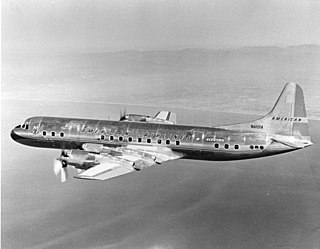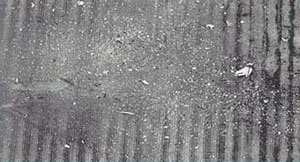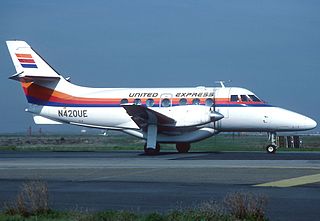
Akron–Canton Airport is a commercial airport in the city of Green, in southern Summit County, Ohio. The airport is located about 14 miles (23 km) southeast of Akron and 10 miles (16 km) northwest of Canton. It is jointly operated by Summit County and Stark County. The airport is a "reliever" airport for Northeast Ohio and markets itself as "A better way to go", emphasizing the ease of travel in comparison to Cleveland Hopkins International Airport. Just under 90% of its traffic is general aviation. It is included in the Federal Aviation Administration (FAA) National Plan of Integrated Airport Systems for 2019–2023, in which it is categorized as a small-hub primary commercial service facility.

Capital Airlines was a United States trunk carrier, a scheduled airline serving the eastern, southern, southeastern, and midwestern United States. Capital's headquarters were located at Washington National Airport across the Potomac river from Washington, D.C., where crew training and aircraft overhauls were also accomplished. In the 1950s Capital was the fifth largest United States domestic carrier by passenger count after the Big Four air carriers.

American Airlines Flight 320 was a scheduled flight between Chicago Midway Airport and New York City's LaGuardia Airport. On February 3, 1959, the Lockheed L-188 Electra performing the flight crashed into the East River during its descent and approach to LaGuardia Airport, killing 65 of the 73 people on board. Weather conditions in the area were poor, and the aircraft descended through dense clouds and fog. As it approached the runway, it flew lower than the intended path and crashed into the icy river 4,900 feet (1,500 m) short of the runway. American Airlines had been flying the newly-developed Lockheed Electra in commercial service for only about two weeks before the crash, and the accident was the first involving the aircraft type.

Northeast Airlines Flight 823 was a scheduled flight in the United States, from New York City's LaGuardia Airport to Miami International Airport, Florida, which crashed shortly after takeoff on February 1, 1957. The aircraft operating the service was a Douglas DC-6 four-engined propeller airliner, registration N34954, which entered service in 1955. It crashed near Rikers Island, which sent corrections personnel and inmates to rescue and assist survivors.

American Airlines Flight 157, a Douglas DC-6, departed on November 29, 1949, from New York City bound for Mexico City with 46 passengers and crew. After one engine failed in mid-flight, a series of critical mistakes by the flight crew caused the pilot to lose control of the plane during the final approach to a routine stopover at Love Field in Dallas, Texas. The airliner slid off the runway and struck a parked airplane, a hangar, and a flight school before crashing into a business across from the airport. 26 passengers and two flight attendants died. The pilot, co-pilot, flight engineer, and 15 passengers survived.

American Eagle Flight 4184, officially operating as Simmons Airlines Flight 4184, was a scheduled domestic passenger flight from Indianapolis, Indiana, to Chicago, Illinois, United States. On October 31, 1994, the ATR 72 performing this route flew into severe icing conditions, lost control and crashed into a field, killing all 68 people on board in the high-speed impact.

American Airlines Flight 383 was a nonstop flight from New York City to Cincinnati on November 8, 1965. The aircraft was a Boeing 727, with 57 passengers, and 5 crew on board. The aircraft crashed on final approach to the Cincinnati/Northern Kentucky International Airport located in Hebron, Kentucky, United States. Only three passengers and one flight attendant survived the accident.
Aircraft upset is an unacceptable condition, in aircraft operations, in which the aircraft flight attitude or airspeed is outside the normally intended limits. This may result in the loss of control (LOC) of the aircraft, and sometimes the total loss of the aircraft itself. Loss of control may be due to excessive altitude for the airplane's weight, turbulent weather, pilot disorientation, or a system failure.

Capital Airlines Flight 20 was a U.S. scheduled passenger flight from Washington, D.C. to Norfolk, Virginia. A Vickers Viscount flying the route crashed into a farm in Charles City County, Virginia, on January 18, 1960. The accident was the fourth fatal crash involving a Capital Viscount in less than two years; the first three were Capital Airlines Flight 67, Capital Airlines Flight 300 and Capital Airlines Flight 75.
On July 28, 1943, American Airlines Flight 63 was flown by a Douglas DC-3, named Flagship Ohio, routing Cleveland-Columbus-Dayton-Cincinnati-Louisville-Nashville-Memphis, that crashed on the Louisville-Nashville sector about 1.6 miles (2.6 km) west of Trammel, Kentucky. The aircraft descended from 200 feet (61 m) until it struck trees, then slid across an open field and stopped in an upright position. Of the 22 people on board, 20 died. The cause of the crash was loss of control due to severe turbulence and violent downdrafts.

American Airlines Flight 28 was a scheduled domestic passenger flight that crashed on October 23, 1942, in Chino Canyon near Palm Springs, California, United States, after being struck by a United States Army Air Forces B-34 bomber. The B-34 suffered only minor damage, and landed safely at the Army Airport of the Sixth Ferrying Command, Palm Springs.

United Express Flight 2415 was a regularly scheduled flight in the northwest United States from Seattle to Pasco, Washington, operated using a BAe Jetstream 31. Late on Tuesday, December 26, 1989, Flight 2415 crashed while attempting to land at Pasco's Tri-Cities Airport, killing both pilots and all four passengers aboard.

Marion Municipal Airport is three miles northeast of Marion, in Marion County, Ohio. The FAA's National Plan of Integrated Airport Systems for 2011–2015 categorized it as a general aviation facility.

Pan Am Flight 923 was a Douglas DC-4 operating from Seattle, Washington to Juneau, Alaska, which crashed into Tamgas Mountain on Annette Island, Alaska, on October 26, 1947. All 18 passengers and crew on board were killed.
American Eagle is a brand name for the regional branch of American Airlines, under which six individual regional airlines operate short- and medium-haul feeder flights. Three of these airlines, Envoy Air, Piedmont Airlines, and PSA Airlines, are wholly owned subsidiaries of the American Airlines Group. American Eagle's largest hub is Charlotte Douglas International's Concourse E, which operates over 340 flights per day, making it the largest regional jet operation in the world.

Ryan International Airlines Flight 590 was a cargo flight carrying mail for the United States Postal Service from Greater Buffalo International Airport (BUF) in Buffalo, New York, to Indianapolis International Airport (IND) in Indiana, with a stopover at Cleveland Hopkins International Airport (CLE) in Cleveland, Ohio. On February 17, 1991, the McDonnell Douglas DC-9-15RC operating the flight crashed on takeoff from Cleveland during icing conditions. Both pilots, the aircraft's only occupants, were killed. The National Transportation Safety Board (NTSB) determined that the causes of the crash were the flight crew failing to deice their aircraft, and the inexperience of the Federal Aviation Administration (FAA), McDonnell Douglas, and Ryan International Airlines with icing condition on DC-9-10 aircraft.

Northwest Orient Airlines Flight 324 was a military charter flight from Haneda Airport to McChord Air Force Base. On the morning of January 19, 1952, the flight crashed into Hecate Strait in British Columbia, Canada, while making an emergency landing at Sandspit Airport. All three crew members and 33 of the 40 passengers were killed, making the flight the third-deadliest aviation accident in Canada at the time.














